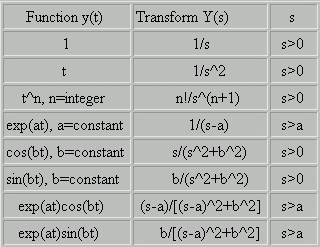The inverse Laplace transform of the function Y(s)
is the unique
function y(t) that is continuous on
[0,infty) and satisfies
L[y(t)](s)=Y(s). If all
possible functions y(t) are discontinous one
can select
a piecewise continuous function to be the inverse
transform.
We will use the notation
![]()
or Li[Y(s)](t) to denote the inverse Laplace transform of Y(s).
Determining the Inverse Laplace Transform
The Laplace transform Y(s) of a function y(t) defined on
[0,infty) is
defined by an integral. It turns out that
formula for determining y(t)
given Y(s) also involves
an integral. The integral is complex valued
integral, and
its evaluation is beyond the scope of this course. For
this reason we take a more pedestrian approach in
computing the
inverse transform. We will use tables and a
few tricks.

There are only small number of functions listed in the
table. The set
of invertible functions can be increased
by exploiting linearity.
Linearity of the Inverse Transform
Let y_1(t) and y_2(t) be the inverse Laplace transforms
of Y_1(s)
and Y_2(s), respectively, and let c be a constant.
We have
![]()
![]()
As a corollary, we have a third formula:
![]()
Here are several examples. What is the inverse transform of
7/s^3?
From the table above we know that the inverse of
2/s^3 is y(t)=t^2.
Hence
![]()
Consider the Laplace transform Y(s)=(3s+4)/(s^2+4). Using the
table
above, we know that the inverse of s/(s^2+4) is cos(2t)
and that the
inverse of 2/(s^2+4) is sin(2t). Hence:
![]()
[ODE Home] [1st-Order Home] [2nd-Order Home] [Laplace Transform Home] [Notation] [References]
Copyright © 1996 Department of Mathematics, Oregon State University
If you have questions or comments, don't hestitate to contact us.